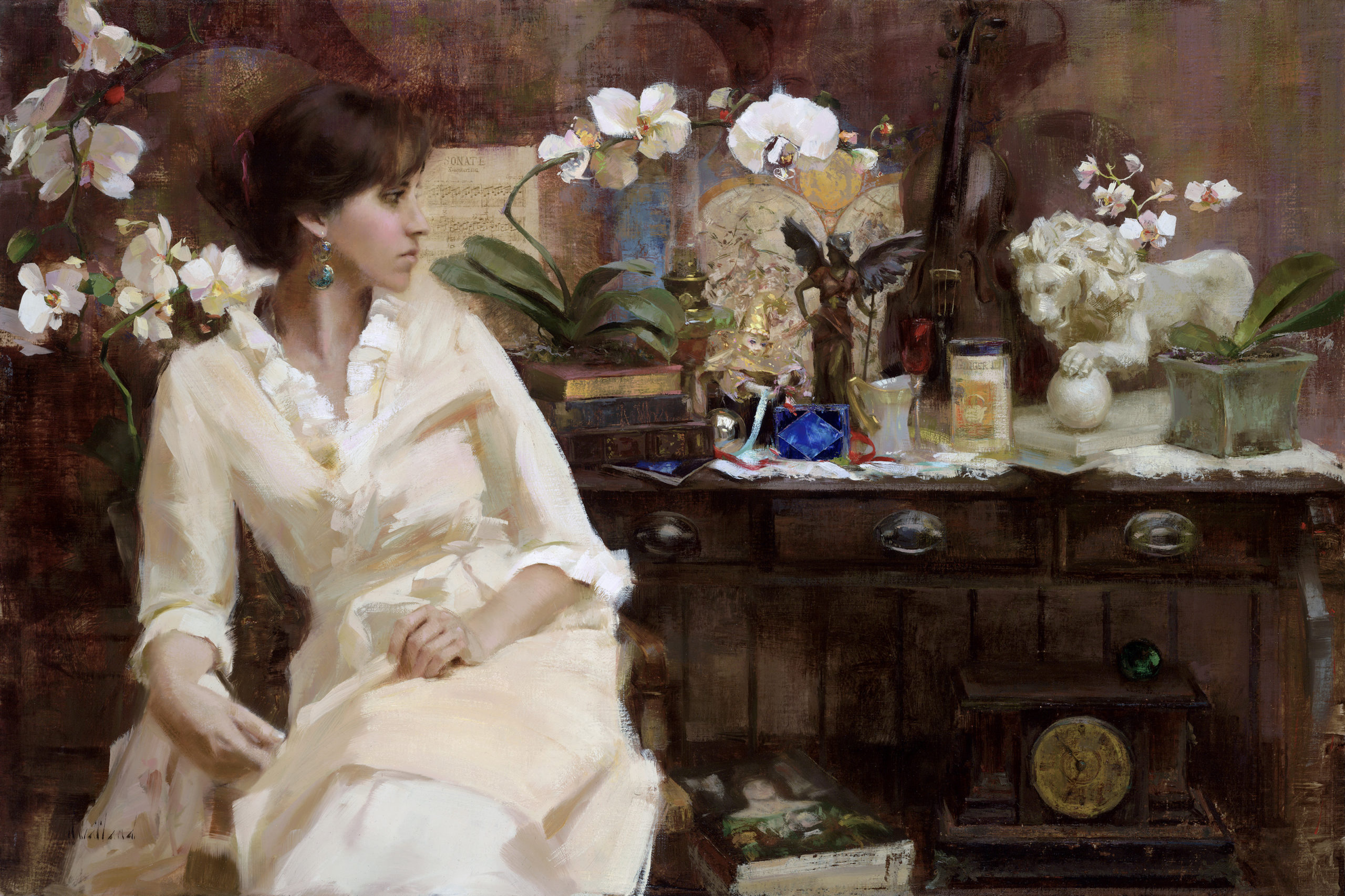The Influence of Figurative Oil Painting on Modern Art and Culture
The Duty of Feeling and Expression in Metaphorical Oil Painting: An Extensive Analysis of Topic and Structure
The interplay of feeling and expression in figurative oil paint offers as a critical lens via which one can analyze the detailed connection in between subject matter and make-up. Artists harness various methods, from shade selection to brushstroke characteristics, to cultivate emotional vibration within their works.
Understanding Feeling in Art
Emotion in art works as an effective avenue for expression, permitting musicians to share complex sensations via their work. In metaphorical oil paint, this psychological depth is often depicted via the representation of the human figure, capturing the nuances of human experience. The option of subject matter, color scheme, and brushwork all add to the emotional vibration of an item.
Artists often bring into play individual experiences, social issues, or global themes to evoke feelings in the audience. For instance, a portrait may show susceptability, while a dynamic figure in movement can represent liberty or chaos. These psychological threads link the customer to the art work, cultivating a discussion that goes beyond the aesthetic tool.
Moreover, the interplay in between light and shadow can enhance emotional intensity, guiding the visitor's look and accentuating particular aspects within the structure. The use of structure in oil painting even more adds layers of complexity, inviting a tactile response that boosts the psychological experience. Overall, understanding feeling in art is crucial for appreciating the nuances that define metaphorical oil paint, as it changes mere representation right into an extensive expedition of the human condition.
Crucial Element of Make-up
In the world of metaphorical oil painting, the composition offers as the underlying structure that arranges aesthetic components and improves the emotional narrative. Vital elements of composition consist of balance, comparison, prime focus, and rhythm, each contributing to the total effect of the artwork.
Equilibrium refers to the distribution of aesthetic weight within the painting, which can be attained through symmetrical or unbalanced plans. A healthy structure provides security, allowing the visitor to engage with the item harmoniously - figurative oil painting. Comparison, on the other hand, includes juxtaposing different aspects, such as light and dark or warm and awesome shades, to direct the visitor's eye and evoke psychological reactions
The focal factor is important, as it routes interest to the most considerable component of the paint, typically highlighting the emotional core of the narrative. By masterfully incorporating these vital components, artists can craft compelling and emotionally powerful figurative oil paintings that mesmerize and engage their audience.
Topic Issue and Its Effect
Topic plays a pivotal role in figurative oil painting, as it not only acts as the structure for the story yet also forms the viewer's interpretation and emotional engagement with the artwork. The selection of subject matter-- be it a solitary figure, a group dynamic, or a thematic depiction-- directly influences the psychological environment conveyed to the audience.

For example, portraits commonly stimulate individual connections, disclosing the complexities of human expression and character, while scenes illustrating public tasks can produce a feeling of belonging or nostalgia. The historical and social context of the subject matter enhances the customer's understanding, triggering deeper representations on societal norms, worths, and the human problem.
Various subjects additionally create differing degrees of engagement; a websites remarkable problem portrayed with numbers in tension may evoke feelings of stress and anxiety or compassion, while serene landscapes can invoke harmony and reflection. Ultimately, the effect of subject issue in metaphorical oil paint is profound, as it serves as a channel for psychological vibration, leading the viewer's reaction and analysis, and promoting a link in between the observer and the artwork. This interplay is crucial for the successful communication of the artist's intent.
Methods for Stimulating Sensations
The performance of figurative oil painting in communicating feelings is dramatically affected by the strategies employed by the artist. One of the most essential methods is making use of shade theory, where the calculated option of hues can evoke particular emotional responses. Warm shades, such as reds and oranges, usually elicit feelings of passion or hostility, while cooler tones like blues and eco-friendlies have a tendency to evoke calmness or unhappiness.
An additional necessary technique is the adjustment of light and shadow, called chiaroscuro. This approach boosts the three-dimensionality of figures, creating significant contrasts that can increase psychological depth. The placement of light can lead visitors' feelings, highlighting details aspects of the structure.
Brushwork also plays a crucial function; loose, expressive strokes can convey power and spontaneity, whereas smoother methods might suggest tranquility or accuracy. Moreover, the setup of topics within the structure can affect psychological impact. Close proximity can recommend intimacy, while range may show seclusion.
Eventually, the combination of these methods enables musicians to craft stories that resonate with the visitor, transforming a plain visual experience into an evocative psychological trip. - figurative oil painting

Situation Researches of Noteworthy Functions
Examining noteworthy jobs of figurative oil painting exposes just how various methods are employed to evoke effective emotions. One excellent instance is Edvard Munch's "The Scream," article where the altered number and swirling background communicate existential fear. Munch's usage of shade-- dazzling oranges and deep blues-- magnifies the emotional effect, showcasing just how scheme selections can form visitor experience.
One more substantial job is Pablo Picasso's "Les Demoiselles d'Avignon." Below, fragmented forms and vibrant brushstrokes show a troubled psychological landscape, challenging typical depictions of the women figure. Picasso's innovative structure not just catches the audience's attention but additionally invites consideration on styles of identity and sexuality.
In Addition, Frida Kahlo's "The 2 Fridas" provides a touching exploration of duality and self-identity. The different numbers, linked by a shared heart, exemplify Kahlo's psychological deepness and personal story. figurative oil painting. Her careful focus to information and symbolic aspects serve to involve audiences on a visceral degree
These instance research studies underscore the extensive connection between feeling and structure in figurative oil paint, exposing exactly how artists harness strategy to interact complex sensations and stories that resonate throughout time and culture.

Conclusion
In verdict, the interplay of feeling and expression in figurative oil paint dramatically improves the visitor's experience and interpretation of the art work. Via a mindful selection of subject and compositional techniques, artists share profound stories that resonate on both universal and personal degrees. The application of shade brushwork, theory, and chiaroscuro further magnifies psychological depth, changing each canvas right into a powerful reflection of the intricacies of the human experience.
In metaphorical oil paint, this emotional deepness is frequently depicted via the representation of the human figure, catching the subtleties of human experience.Moreover, the interplay in between see this page light and darkness can intensify emotional strength, leading the viewer's gaze and drawing interest to particular elements within the structure. The use of structure in oil paint further includes layers of intricacy, welcoming a responsive action that boosts the emotional experience.The focal point is important, as it guides interest to the most considerable part of the paint, frequently highlighting the emotional core of the narrative. Ultimately, the impact of subject matter in figurative oil painting is profound, as it offers as an avenue for psychological vibration, guiding the viewer's response and analysis, and cultivating a link between the artwork and the observer.